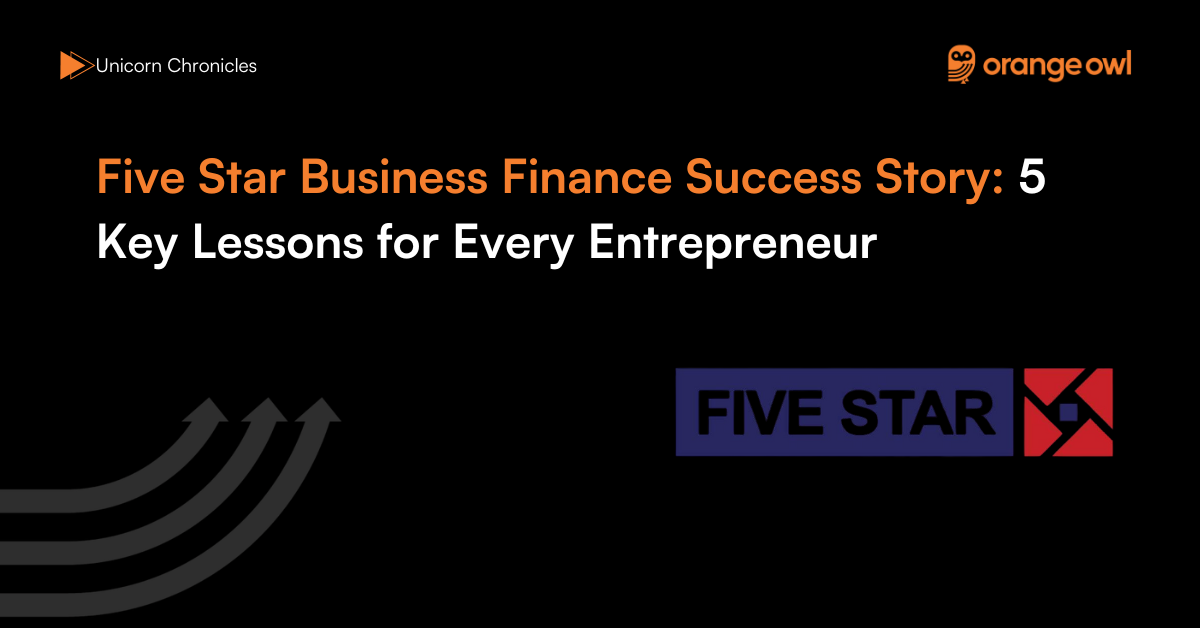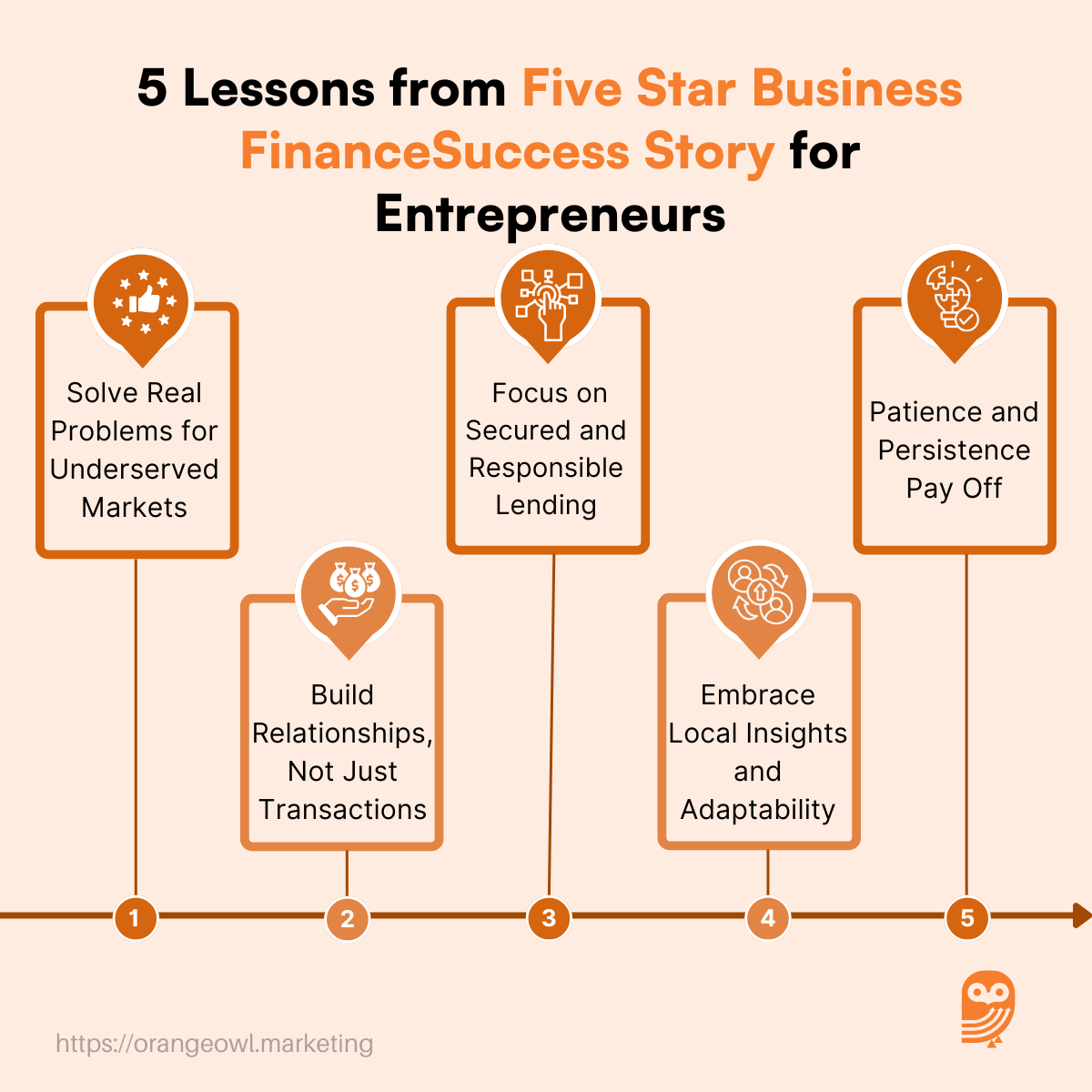Five Star Business Finance Success Story 5 Key Lessons for Every Entrepreneur
Vivek Goel
June 17, 2025

Table of Contents
Introduction
In a country where millions of small businesses remain underserved by traditional banking, Five Star Business Finance has quietly built a lending powerhouse that bridges the credit gap for India’s informal economy. While flashy fintech startups chase rapid growth and digital disruption, Five Star took a different path—focusing on a brick-and-mortar presence, strong underwriting discipline, and a deep understanding of the grassroots borrower.
Founded in 1984 by V. Rangarajan and later revitalised by V.K. Ranganathan (Pati), D. Lakshmipathy, and G. Anantharaman, Five Star grew steadily by extending secured loans to small entrepreneurs—think kirana shop owners, tailors, and micro-entrepreneurs—who lacked formal income proof but had real assets and strong repayment intent. By 2023, the company had disbursed over ₹20,000 crore in loans, maintained one of the lowest NPAs in the industry, and became a unicorn after raising ₹1,588 crore in its IPO.
With a presence across 8,000+ towns and a customer base that’s nearly invisible to most digital lenders, the Five Star Business Finance success story shows that patient, ground-up lending can scale sustainably without compromising on asset quality. Its journey is a compelling playbook for building a high-quality NBFC in India’s most underserved financial segment.
Origin Story
Five Star Business Finance began its journey in 1984, long before startups and unicorns became part of India’s business vocabulary. It was initially founded by V. Rangarajan, a seasoned banker who envisioned a financial institution that could provide secured loans to underserved borrowers in Chennai. For nearly two decades, Five Star operated as a traditional lender, serving a limited regional clientele with a conservative approach.
The turning point came in the early 2000s, when V.K. Ranganathan (Pati)—a former executive at Sundaram Finance—took over as the company’s Chairman and Managing Director. Recognising the vast unmet credit demand in India’s informal economy, he began rethinking Five Star’s mission and operating model. Around 2012, a second transformation was led by D. Lakshmipathy, who joined as Executive Director and later became CEO. Lakshmipathy brought fresh energy and focus, championing data-driven credit underwriting, a hub-and-spoke model, and deep penetration into Tier 3 and Tier 4 towns.
In an interview, Lakshmipathy shared:
“We didn’t go after salaried professionals in metros. We went to places where no one else was willing to lend—and met people who just needed a fair chance.”
With no access to formal banking, these customers often relied on local moneylenders who charged exorbitant rates. Five Star positioned itself as a trust-based lender, offering secured loans against property collateral, supported by rigorous field-level verification and low ticket sizes. The company grew not by chasing hype or valuation, but by staying hyper-focused on the middle- and lower-income self-employed borrower.
By the time fintechs began flooding the market, Five Star had already built a high-quality loan book, a robust field force, and a solid profit track record, earning its place as one of India’s most respected and profitable NBFCs.
Business Landscape and Challenges
When Five Star Business Finance began its reinvention in the 2000s, it stepped into a space that was both massive in opportunity and riddled with challenges—secured lending to self-employed, informal sector borrowers. These were customers who ran kirana stores, operated tiffin centres, repaired bikes, or ran small workshops in semi-urban and rural towns. They had no formal income proof, limited credit history, and were often invisible to banks.
The mainstream financial system largely ignored them. Traditional banks saw them as too risky. Fintech lenders found it hard to underwrite without data. As a result, these borrowers relied on local moneylenders who charged usurious interest rates and operated with little transparency.
Five Star entered this gap with a bold proposition: offer small-ticket secured loans (typically between ₹1–10 lakh) to borrowers who could pledge residential or commercial property, even if their income was irregular. But the real challenge lay in execution. These borrowers couldn’t be evaluated through traditional credit scoring. As CMD P.K. Ranganathan put it in a talk:
“We had to go beyond the balance sheets. We had to understand the cash flows, intent, and capacity of our borrowers personally.”
The early challenges were immense. The company had to:
- Build a boots-on-the-ground underwriting model based on deep field visits and character assessment.
- Operate in low-yield geographies with high operational intensity.
- Navigate regulatory uncertainties as NBFC norms evolved.
- Create a tech-light but process-strong credit system that balances local knowledge with centralised monitoring.
Unlike VC-funded startups, Five Star didn’t grow by blitzscaling. Instead, it relied on tight controls, risk management, and a deep understanding of borrower behaviour. In the absence of flashy tech, it built its advantage on discipline and trust, delivering industry-leading asset quality, even as it scaled across over 500 branches in Tier 3 and Tier 4 towns.
Over time, what looked like a fragmented and high-risk segment turned out to be a defensible and profitable moat—because Five Star had done the hard work of building systems that could evaluate and serve India’s unbanked entrepreneurs at scale.
Growth Strategies
Five Star Business Finance’s success story wasn’t driven by aggressive customer acquisition or headline-grabbing tech. Instead, its growth was measured, disciplined, and grounded in fundamentals. Every branch, loan, and rupee was evaluated through the lens of risk-adjusted return—a sharp contrast to many fintechs chasing topline growth.
Here’s how Five Star scaled a high-quality, high-yield lending business in India’s heartland:
Credit-first approach:
Five Star was laser-focused on asset quality from day one. It maintained strict credit underwriting practices that emphasised borrower intent, local reputation, and real-world cash flows, often ignoring credit bureau scores altogether.
Branch-led expansion:
Unlike many digital-only players, Five Star grew via a hub-and-spoke branch model. It carefully selected towns with strong MSME activity, built local teams, and established a deep community presence. As V.K. Ranganathan noted,
“We never believed in growing faster than we could control.”
Property-backed lending:
Instead of unsecured loans, Five Star stuck to small-ticket, fully secured lending against residential or commercial property. This ensured a high collection rate and near-zero NPAs, even through economic cycles.
Unit economics obsession:
Five Star didn’t chase GMV or flashy growth metrics. Every loan was expected to be profitable on a standalone basis. The company maintained one of the lowest cost-to-income ratios in the NBFC space by keeping overheads lean and processes tight.
Minimal dilution, long-term investors:
Rather than raising successive venture rounds, Five Star brought in patient capital from investors like TPG, Norwest, and Sequoia Capital. These partners aligned with the company’s long-term view, allowing it to scale without compromising discipline.
This combination of risk-aware growth and operational rigour helped Five Star expand to over 150 districts across India, with AUM surpassing ₹5,000 crore while maintaining industry-best credit metrics.
Five Star didn’t just build a lending business — it built a trust engine that fueled entrepreneurship in India’s most overlooked geographies.
Marketing Strategy
Five Star Business Finance’s marketing strategy was quietly powerful, relying on deep local relationships and impeccable reputation rather than flashy advertising or mass media campaigns. Its approach reflected the realities of lending in India’s smaller towns and semi-urban markets.
Key elements included:
Community trust building:
Five Star’s branches became trusted neighbourhood financial partners. The company invested heavily in building personal relationships with customers, brokers, and local influencers who acted as ambassadors for the brand.
Referral-driven growth:
Customer acquisition was predominantly through word-of-mouth and broker networks. Satisfied borrowers and community leaders helped Five Star expand organically without the need for expensive marketing spends.
Localised outreach:
Five Star ran targeted local events and financial literacy programs to educate MSMEs and individuals about credit and loans, which helped establish credibility and demystify borrowing.
No consumer advertising:
Unlike many NBFCs or fintech lenders, Five Star avoided mass media or digital advertising campaigns. It is believed that lending — especially secured lending — was a relationship business that required trust, not hype.
Strong investor communications:
Five Star maintained transparent and consistent communications with investors and partners, which bolstered confidence and positioned the company as a stable, reliable player in a risky sector.
Through this relationship-first marketing strategy, Five Star carved a niche in underserved markets and built a loyal borrower base that fuels its steady growth.
5 Key Lessons for Every Entrepreneur
1. Solve Real Problems for Underserved Markets
Five Star Business Finance didn’t chase glamorous sectors like consumer apps or fintech buzzwords. Instead, it focused on meeting the credit needs of MSMEs and individuals in small towns and semi-urban areas — a segment often ignored by big banks. By addressing this huge but underserved market, Five Star created immense value and built a loyal customer base.
“Understanding and serving real, persistent problems creates sustainable opportunity,” said CMD P.K. Ranganathan.
2. Build Relationships, Not Just Transactions
Unlike digital-only lenders, Five Star emphasised deep, trust-based relationships with customers and local brokers. Lending is a people business, especially in emerging markets, and this relationship-first approach helped Five Star win customer loyalty, reduce defaults, and scale steadily.
Entrepreneurs should remember that trust and personal connections are assets that technology alone can’t replace.

3. Focus on Secured and Responsible Lending
Five Star’s success came from its disciplined underwriting and secured lending model, which minimised risk while expanding credit access. This careful approach helped the company maintain asset quality even in volatile markets, proving that responsible lending drives long-term growth.
Startups in financial services must balance scale with risk management to build sustainable businesses.
4. Embrace Local Insights and Adaptability
Operating in diverse regions requires deep local market understanding. Five Star’s decentralised branch network empowered teams to tailor products and processes for their communities. This adaptability was key to gaining trust and overcoming regional challenges that national players often miss.
Entrepreneurs should recognise that local relevance can be a powerful competitive advantage.
5. Patience and Persistence Pay Off
Five Star’s growth wasn’t overnight. It took years of consistent effort, relationship building, and prudent expansion to become a leading NBFC. The company shows that success in financial services, especially in complex markets, requires long-term commitment rather than quick wins.
As V.K. Ranganathan puts it, “Patience, discipline, and steady execution are the pillars of sustainable success.”
Conclusion
The Five Star Business Finance success story is a powerful example of how deep market insight, relentless focus, and a commitment to underserved segments can build a company that truly transforms lives. By catering to the credit needs of micro and small businesses, Five Star has created a robust financial platform that empowers entrepreneurs and fuels economic growth across India’s diverse regions.
Their journey underscores the importance of trust-driven growth, customer-centric innovation, and strong governance in overcoming challenges and scaling sustainably in a complex financial landscape. The founders’ vision of inclusive finance and patient execution serves as a beacon for startups looking to make a meaningful impact beyond quick gains or hype.
As the Indian financial ecosystem continues to evolve, Five Star Business Finance is well-positioned to deepen its role in driving financial inclusion and entrepreneurial empowerment. Their story shows that solving real-world problems with integrity and persistence can unlock enormous long-term value, often quietly but powerfully.
As P.K. Ranganathan, CMD of Five Star Business Finance, aptly said,
“Our mission has always been to give businesses the financial support they deserve, helping them grow and create jobs that uplift communities.”
For entrepreneurs and investors alike, the Five Star Business Finance success story is a compelling reminder that the true power of fintech lies in making finance accessible and meaningful for those who need it most.


